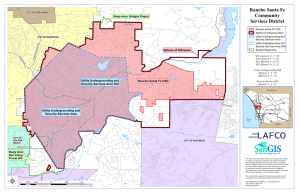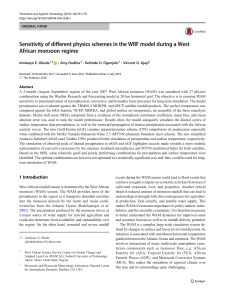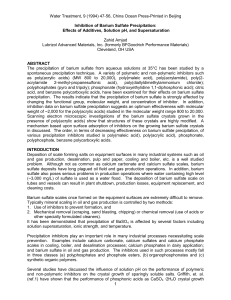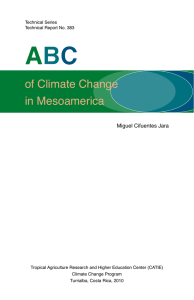North Atlantic Oscillation (NAO) and precipitation in - E
Anuncio
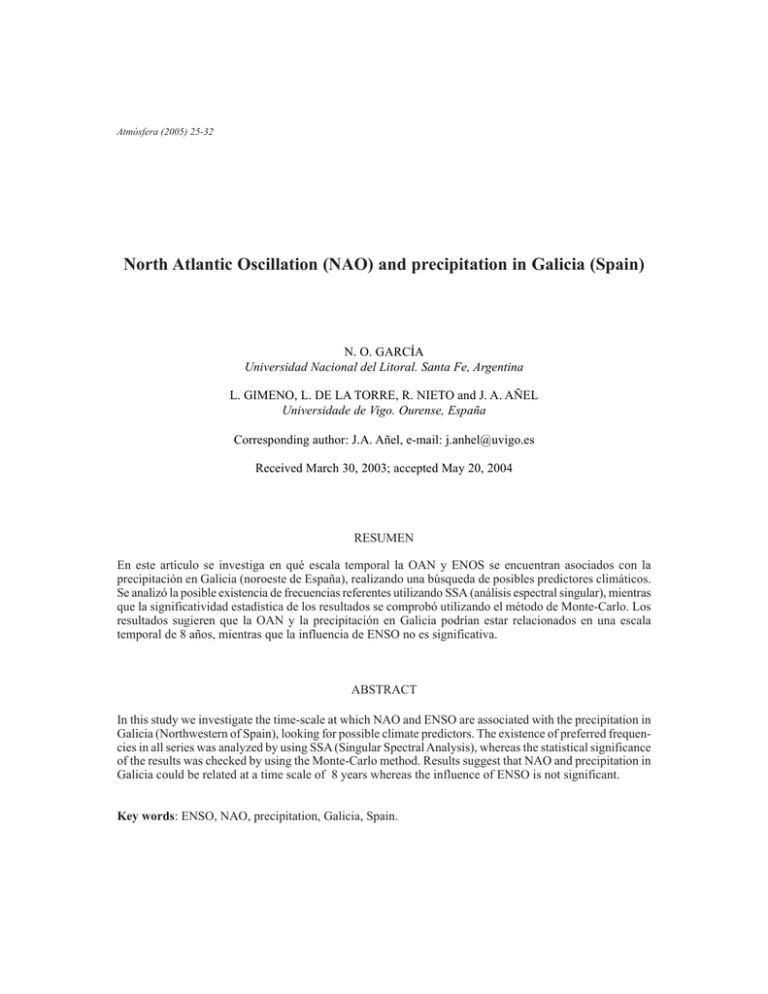
Atmósfera (2005) 25-32 North Atlantic Oscillation (NAO) and precipitation in Galicia (Spain) N. O. GARCÍA Universidad Nacional del Litoral. Santa Fe, Argentina L. GIMENO, L. DE LA TORRE, R. NIETO and J. A. AÑEL Universidade de Vigo. Ourense, España Corresponding author: J.A. Añel, e-mail: j.anhel@uvigo.es Received March 30, 2003; accepted May 20, 2004 RESUMEN En este artículo se investiga en qué escala temporal la OAN y ENOS se encuentran asociados con la precipitación en Galicia (noroeste de España), realizando una búsqueda de posibles predictores climáticos. Se analizó la posible existencia de frecuencias referentes utilizando SSA (análisis espectral singular), mientras que la significatividad estadística de los resultados se comprobó utilizando el método de Monte-Carlo. Los resultados sugieren que la OAN y la precipitación en Galicia podrían estar relacionados en una escala temporal de 8 años, mientras que la influencia de ENSO no es significativa. ABSTRACT In this study we investigate the time-scale at which NAO and ENSO are associated with the precipitation in Galicia (Northwestern of Spain), looking for possible climate predictors. The existence of preferred frequencies in all series was analyzed by using SSA (Singular Spectral Analysis), whereas the statistical significance of the results was checked by using the Monte-Carlo method. Results suggest that NAO and precipitation in Galicia could be related at a time scale of 8 years whereas the influence of ENSO is not significant. Key words: ENSO, NAO, precipitation, Galicia, Spain. 26 L. Gimeno, et al. 1. Introduction Changes in the atmospheric circulation have an important role in the interannual and interdecadal variability of precipitation. Rainfall patterns can change in midlatitudes through a shift in storm tracks associated with teleconnections. A dipole pattern of change over Europe has been widely documented, with lower rainfalls over southern Europe and wetter conditions in Scandinavia associated to the positive phase of the North Atlantic Oscillation (NAO) (Hurrell 1995, Hurrell and van Loon, 1997; Giannini et al., 2000). El Niño Southern Oscillation (ENSO) and the Pacific North America Oscillation (PNA) are associated to changes in storm tracks over the North Pacific leading to a dipole pattern of precipitation anomalies over California and the southeastern United States (Trenberth and Hurrell 1994). Furthermore, due to the global effect of ENSO on the general circulation of the atmosphere, floods and droughts in different locations around the globe are associated with ENSO through teleconnections (Ropelewski and Halpert, 1987, 1989a,b; Dai et al.1998). The precipitation regime in the Iberian Peninsula has a highly irregular behavior in both the spatial and temporal dimensions (Esteban-Parra et al., 1998; Serrano et al., 1999; Trigo and DaCamara, 2000). It is important to notice that winter and spring precipitation variability can be explained as a function of changes in large-scale modes at a monthly scale, especially over the western sector of the Iberian Peninsula (Rodríguez-Puebla et al., 1998; Trigo and Palutikof, 2001). Among these modes, the North Atlantic Oscillation is largely the most important element to model the winter precipitation regime over the Iberian Peninsula (Rodó et al., 1997; Rodriguez-Puebla et al., 1998; Corte-Real et al., 1998; González-Rouco et al., 2000; Trigo and Palutikof, 2001). The typical pressure dipole pattern that characterizes NAO is clearly associated with changes in the vorticity field, so the maximum value of positive vorticity is moved a few degrees northwards for positive NAO respect to negative NAO. Positive vorticity is associated to low level convergence and uplift, so the condensation of perceptible water content is clearly related to NAO The main aim of this work is to study the relationship between NAO and precipitation amounts in Galicia, a region located in the Northwest of Spain, focusing the study on the search of the preferred time scale of the relationship. We will also try to find out if there is also a relationship with ENSO, a phenomenon located in the tropical Pacific that has implications in the climate all over the globe. Spectral analysis (SA) and singular spectral analysis (SSA) were computed following Vautard et al. (1992), whereas statistical significance was checked using the Monte-Carlo method by means of a first order autoregressive model, AR(1) (Allen and Smith, 1996). 2. Data In order to measure NAO and ENSO phenomena, two pressure indices were used: NAO index (Jones et al., 1997) and the Southern Oscillation Index (SOI), both available at http: www.cru.uea.ac.uk. Precipitation data were provided by the Spanish National Meteorological Institute (Table1). NAO and precipitation in Galicia 27 Table 1. Precipitation stations used. Nº Station Lat. N 1 2 3 4 5 6 7 8 9 10 Boñar Cervera Grado La Coruña Puenteareas Requejo Santiago de Compostela Sarría Villameca Zamora 42.86 42.86 43.38 43.38 42.18 42.03 42.90 42.78 42.64 41.50 Long. W 5.32 4.50 6.06 8.38 8.49 6.75 8.43 7.41 6.07 5.76 Period 1914-1998 1913-1998 1942-1998 1931-1998 1939-1998 1943-1998 1944-1998 1946-1998 1931-1998 1920-1998 SSA was used to look for periodicities and to determine the spatio-temporal structure of the data in the interannual frequency band. This technique is based in principal components analysis. When two phenomenon have the same periodicities, there is a high probability of one phenomenon forcing the other. In order to assure the significance of the spectral peaks, a Monte-Carlo method was used, starting from a first order autoregressive model. 3. Results A SA was calculated for SOI (Fig. 1) and NAO index (Fig. 2), looking for significant periodicities. For both magnitudes, the spectra show few peaks above noise, with no coincidence between them. Cycles found in NAO index correspond to periods of 8.0, 5.8, 2.4 and 2.2 years, whereas those years years Fig. 1. Southern Oscillation Index (SOI) (1866-2000). L. Gimeno, et al. 28 Fig 2. NAO Spectrum (1866-2000). found in SOI correspond to 6.4 and 3.5 years. The only common characteristic is the high degree of red noise. This result is slightly different to that reached by García et al. (2000) who found a significant common oscillation of 6-8 years that represents about 20% of the SOI variance and about 25% of the NAO variance. However these authors advised of the limitations of the results due to the length of the used series. Results obtained using SSA for NAO index and SOI are shown in Table 2 for the first eigenvalues. The lack of coincidence between the indices is also evident in this case, although in some cases the difference is small. Obviously, the oscillation modes in NAO and SOI are not the same. Applying the Monte-Carlo method to the NAO index (Fig. 3), it is found that none of the cycles is significant at 95% significance level, although the significance of the 8 years cycle is good enough to consider it as a real cycle. This result is clearly in agreement with other studies looking for spectral peaks in the NAO series (e.g. Pozo-Vázquez et al., 2000). The results of SSA for precipitation using hydrological years are shown in Table 3. Five stations share a common oscillation period of 8.4 years, very similar to that of 8.3 years found in NAO Table 2. Dominant periods and explained variance. Index Period (years) Explained variance (%) NAO 8.2 2.9 5.0 13.0 17.9 16.1 12.1 10.8 SOI 6.4 3.5 4.7 20.8 17.4 13.0 NAO and precipitation in Galicia 29 Fig. 3. SSA (M = 40) of NAO Index. Null hypothesis test derived from covariance matrix. Substitute ensemble size: 1000. Table 3. Dominant frequencies of precipitation for all the hydrological years (October-March). Index Period (years) Explained variance (%) La Coruña 8.4 4.2 3.0 36.0 25.6 16.3 Santiago de Compostela 8.4 2.6 3.9 42.5 17.6 15.0 Ponteareas 4.2 2.6 8.4 31.1 25.7 21.0 Sarría 5.3 8.4 3.0 25.8 18.9 11.7 Requejo 3.8 2.6 8.4 4.2 3.0 39.8 21.7 35.5 23.5 9.5 3.2 2.7 5.2 9.0 19.4 11.3 Grado Villameca (Continues in the next page.) L. Gimeno, et al. 30 Table 3. Dominant frequences... (continued) Index Period (years) Explained variance (%) Boñar 4.2 6.0 2.8 35.3 21.4 7.9 Cervera 6.0 3.5 2.8 31.6 26.8 20.1 Zamora 2.6 5.3 3.8 24.3 21.0 16.9 Table 4. Dominant frequencies of precipitation for the hydrological years in which NAO index is positive. Index Period (years) Explained variance (%) NAO 8.3 4.1 3.2 28.9 16.8 14.7 La Coruña 8.4 2.6 3.2 33.4 18.6 15.3 Santiago de Compostela 8.4 2.6 3.5 31.4 23.6 13.5 Ponteareas 2.6 4.2 28.8 20.9 Sarría 8.4 2.6 3.0 31.4 22.9 11.7 Requejo 6.0 2.6 3.8 33.6 25.9 17.4 3.8 12.1 8.4 5.3 2.6 23.2 19.2 13.2 Zamora NAO and precipitation in Galicia 31 index. The 2.6 years cycle seems to have physical significance, since it appears in most of the precipitation series. The link with NAO is even more clear when using only years corresponding to positive phases of NAO (Table 4). In this case, the 8 years cycle is present in all the stations except Ponteareas, Requejo y Villameca. The other repeated cycle (2.6 years) is not related to NAO, however it appears in almost all the stations, so we have to consider it as an important feature in Galician precipitation. 4. Conclusions In this work, relevant aspects of the relationship between NAO and Galician precipitation are shown, which could be useful for seasonal prediction, however results showed a lack of coincidence between SOI and Galician precipitation. The results obtained for precipitation show a high level of coincidence near the coast, whereas variability increases with the distance to the sea, when the whole hydrological year is used. There is a common oscillation in NAO and precipitation with a period of around 8 years, very important for positive NAO phases. This suggest that both NAO and precipitation in Northwestern Spain could have a preferred time domain of relationship (about 8 years) being this effect more accused during positive phases. References Allen, M.R. and L.A. Smith (1996). Monte Carlo SSA: Detecting Irregular Oscillations in the Presence of Colored Noise, J. Climate 9, 3373-3404. Corte-Real J., B. Qian and H. Xu (1998). Regional climate change in Portugal: precipitation variability associated with large-scale atmospheric circulation. Int. J. Climatol. 18, 619-635. Dai, A., K.E.Trenberth and T.R.Karl, (1998). Global variations in droughts and wet spells:19001995. Geophys. Res.Lett. 25, 3367-3370. Esteban-Parra, M.J., F.S. Rodrigo and Y. Castro-Díez (1998). Spatial and temporal patterns of precipitation in Spain for the period 1880-1992. Int. J. Climatol. 18, 1557-1574. García R., P. Rivera, L. Gimeno and E. Hernández (2000) Are the North Atlantic Oscillation and the Southern Oscillation related in any time scale?. Annales Geophysicae 18, 247-251. Giannini, A., Y. Kushnir and M.A. Cane, (2000). Interannual variability of Caribbean rainfall, ENSO and the Atlantic Ocean. J. Climate 13, 297-311. Gonzalez-Rouco, F., E. Zorita, H. Heyen and F. Valero (2000). Agreement between observed rainfall trends and climate change simulations in the southwest of Europe. J. Climate 13, 3057-3065. Hurrell, J.W. (1995). Decadal trends in the North Atlantic Oscillation regional temperatures and precipitation. Science 269, 676 –679. Hurrell, J.W. and H. van Loon (1997). Decadal variations in climate associated with the North Atlantic Oscillation. Climatic Change 36, 301-326. 32 L. Gimeno, et al. Jones, P.D., T. Jónsson and D. Wheeler (1997). Extension to the North Atlantic Oscillation using early instrumental pressure observations from Gibraltar and South-West Iceland. Int. J. Climatol. 17, 1433-1450. Pozo-Vázquez, D., M.J. Esteban-Parra, F.S. Rodrigo and Y. Castro-Diez (2000) An analysis of the variability of the North Atlantic Oscillation in the time and the frequency domains. Int. J. Climatol. 20, 1675-1692. Rodó, X., E. Baert and F.A. Comin (1997) Variations in seasonal rainfall in Southern Europe during the present century: relationships with the North Atlantic Oscillation and the El NiñoSouthern Oscillation. Climate Dyn. 13, 275-284. Ropelewski C. F. and M. S. Halpert (1987). Global and regional scale precipitation pattern associated with the El Niño/Southern Oscillation. Mon. Wea. Rev. 115, 1606-1626. Ropelewski C. F. and M. S. Halpert (1989a). Precipitation pattern associated with the high index phase of the Southern Oscillation. J. Climate 2, 268-284. Ropelewski, C.F. and M.S. Halpert (1989b). Quantifying Southern Oscillation-precipitation relationships. J. Climate 9, 1043-1059. Rodríguez-Puebla, C., A.H. Encinas, S. Nieto and J. Garmendia (1998). Spatial and temporal patterns of annual precipitation variability over the Iberian Peninsula. Int. J. Climatol. 18, 299316. Serrano, A., A.J. García., V.L. Mateos, M.L. Cancillo and J. Garrido (1999). Monthly modes of variation of precipitation over the Iberian Peninsula. J. Climate 12, 2894-919. Trenberth, K.E and J.W.Hurrell (1994).Decadal atmosphere–ocean variations in the Pacific.Climate Dyn. 9, 303-319. Trigo, R.M. and C.C. DaCamara (2000). Circulation weather types and their impact on the precipitation regime in Portugal. Int. J. Climatol 20, 1559-1581. Trigo, R.M. and J.P. Palutikof (2001). Precipitation scenarios over Iberia: a comparison between direct GCM output and different downscaling techniques. J. Climate 14, 4422-4446.




